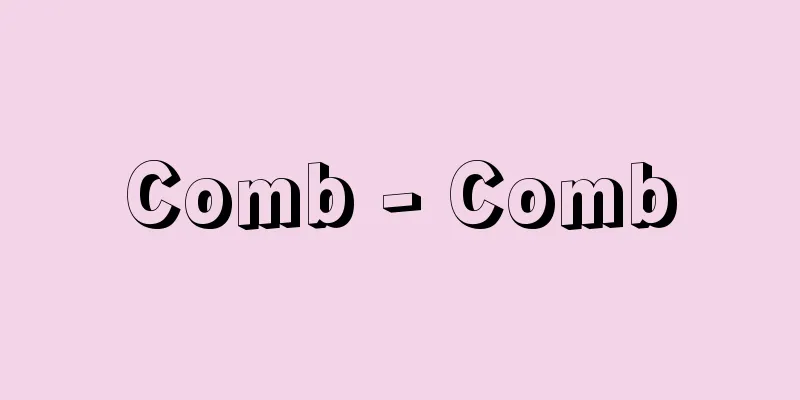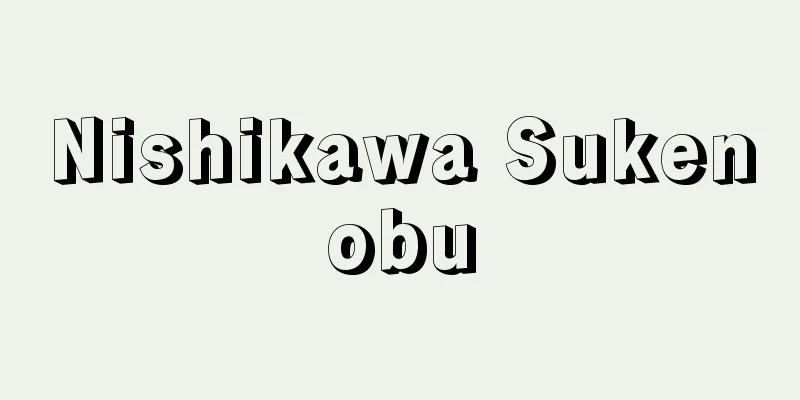Comb - Comb

|
A tool used to comb hair, beard, or eyebrows. It corresponds to the English word "comb" and the French word "peigne" and is also used as a hair ornament or head decoration. [Hirano Yuko] WesternCombs are one of mankind's oldest cosmetic tools, and in primitive times it is thought that not only hands (hand combs) but also thorns from plants, tree branches and fish bones were used for this purpose. Combs in their modern form have ancient origins, and the oldest ones have been discovered in Neolithic ruins, made of bone and bronze. Ancient Egyptian relics include combs made from ivory and hardwoods such as boxwood and ebony, and ancient Greece and Rome also used elaborate combs made from ivory and boxwood. The bronze, wooden and bone combs used by the Germanic people of Northern Europe have intricately carved handles. As hair and beards grew longer and the more elaborate their finishing, combs became an increasingly important tool. In the Middle Ages, the materials used for combs became more abundant, and they began to be used as a type of hair ornament, with decorative features added. During the Renaissance, combs made from metals such as lead and silver, as well as tortoiseshell, appeared, and craftsmen competed to create the most fashionable styles. By the 17th century, combs had become an indispensable accessory for women's hair, and it was customary for men who began to wear wigs to also carry one. During the era when wigs were the main focus of hairstyles, metal combs were the norm. However, from the mid-18th century, combs made from tortoiseshell, ivory, horn, wood, bone, metal, and celluloid began to be produced mechanically, mainly in the United States. In the 19th century, large combs imitating the Greek stephane (crescent-shaped headdress) began to be popular, and in the 1830s, it became fashionable to use beautifully decorated combs to decorate chignons (topknots at the back of the head). Tall, large, decorated combs are a characteristic of the 19th century. From the end of the 19th century to the beginning of the 20th century, side combs and back combs differentiated, and various other combs were born. These were later retained as headdresses for evening gowns. However, with the bob (women's short haircut) of 1920 and the subsequent simple hairstyles becoming fashionable, combs as hair accessories gradually disappeared. [Hirano Yuko] JapanCombs have been found in Japan since the Jomon pottery period, with the oldest combs being those excavated from the Korekawa ruins in Hachinohe, Aomori Prefecture. Among the female figures of human figures, which were actively produced around the 5th and 6th centuries, there is one with a simple Shimada hairstyle and a comb tucked into the hairline of her forehead. As for written sources, the myths and legends in the Kojiki and Nihon Shoki include a story about Izanagi-no-Mikoto breaking a comb in the underworld, and there is evidence of the custom of breaking off the teeth of a comb to light a fire or throwing the comb away. Combs at that time were not horizontal combs like today, but were made by lining up bamboo sticks vertically, heating the center and bending them, and then binding them together with vines. Combs made from bamboo sticks and plated with metal have been excavated from sutra mounds, an archaeological site dating back to the Asuka and Nara periods, when Buddhist culture was at its peak. The shift from vertical combs to horizontal combs occurred during the Heian period, when imitation of Chinese culture became popular, and combs were made from not only Chinese wood but also fangs, which were usually kept in a portable box. Images of people combing hair with a comb can be seen in the National Treasure "The Tale of Genji Illustrated Scroll," but the development of combs did not come until the Edo period, when various changes occurred in hair styling rather than hanging hair, and topknots began to be worn. Of course, combs are made by sawing wood, and a picture of comb-milling can be seen in the Muromachi period "Seventy-one Artisans." Combs began to be made into an art form from the mid-Edo period. The materials used for the combs included ivory, deer antler, crane bone, tortoiseshell, Chinese wood, glass, and metals such as gold, silver, copper, and brass, and they could also be decorated with lacquer, inlay, pearls, glass beads, agate, and coral beads on the ridge of the hair. For practical use, boxwood combs were used, and for adjusting the combs, there were the kesujitate, bindashi, binakasuki, and suki combs, and the shapes of the combs also varied depending on the ridge, including the Masako style, crescent, half moon, square, and Rikyu combs. The way they were worn also varied from the two-layer comb used in the pleasure quarters to the anadanokoshi or kushimaki, the simplest method of hair styling, for the wives of craftsmen. The beauty of a woman wearing a comb was said to continue until the end of the Edo period, but from the Meiji to Showa periods, as people began to wear their hair in a bundle, the use of combs as decoration gradually declined along with the Japanese hairstyle, but among children, rubber ring combs called "kachushas" remained popular until the Taisho period. As people began to cut their hair, combs were no longer used to wear hair in their hair, but were merely used for grooming purposes. [Takeshi Endo] Types and usesEven today, boxwood combs, thinning combs, and hair straighteners are still in use, but Western-style combs are more commonly used, and are made from materials such as plastic, metal, and buffalo horns. (1) Set comb: A comb used to comb or style hair, similar to a side comb. There are combs with the same spacing between the teeth on all sides, and combs with the teeth spaced finer on only half of the sides. (2) Tail comb: As the name suggests, this is a comb with a tail. The tail is used to part hair or separate sections of hair. (3) Coarse-toothed comb: This refers to a comb with coarse teeth. When combing tangled or long strands of hair, it can be used to gradually loosen them from the ends, allowing you to comb the hair without damaging it. (4) Others There are also tail combs for backcombing, color combs for dyeing hair, and razor combs with razor blades. There are also many types of decorative combs to attach to hair, including those with carvings on the top of the teeth or on the handle, and those decorated with jewels, metals, artificial flowers, feathers, ribbons, lace, etc. [Fumisako Yokota] FolkloreA comb is a tool for styling hair, but is also a type of hair ornament. Originally, it had many decorative elements and was worn by certain women during divine festivals and magical ceremonies. In other words, it was a kind of sign of holiness, and in scenes of divine worship, it was also a sign to distinguish the possession of the god from others. In the story of Susanoo-no-Mikoto's slaying of the Yamata-no-Orochi in Izumo, he saves Kushinadahime, who has been offered as a human sacrifice. Kushinada means strange rice field, and she was probably a woman with the character of a shrine maiden who served the grain spirit. During Shinto rituals and festivals, yorimashi (corpses) who are believed to be possessed by divine spirits are often shown wearing a comb on their head, and the custom of inserting a comb into one's head indicates one is married, which also expresses one's existence. Throwing a comb is said to be a curse that will break up a marriage, and there is also the custom of people in unlucky years dropping their combs on the road. This popular belief was popularized as a play on words for parting ways and kushi (painful death), and it is intended to end possessions and to remove misfortune by entrusting it to the comb. [Shoji Inoguchi] "Kitagawa Morisada's 'Ruishū Kinsei Fuzokushi' (1934, Kouseikaku)" ▽ "'Umani-zoshi - Kishi Magotayu Manuscript' (Ansei Era, National Diet Library edition)" [Reference] |(1) Hair straightening (2) Trimming comb (3) Sideburns extension (4) Thinning comb (5) Sideburns comb ©Shogakukan "> Main types of Japanese combs (for adjustment) Source: Shogakukan Encyclopedia Nipponica About Encyclopedia Nipponica Information | Legend |
|
毛髪や髭(ひげ)、あるいは眉毛(まゆげ)をすき整える用具。英語のコームcomb、フランス語のペーニュpeigneにあたり、髪飾りや頭飾りとしても用いられる。 [平野裕子] 西洋櫛は人類最古の化粧用具の一つで、原始時代には手指(手櫛)はもちろん、植物の刺(とげ)、木の枝、魚の骨などがその目的のために使われていたと考えられる。今日的な形状の櫛の起源は古く、最古のものとして、新石器時代の遺跡から骨製、青銅製のそれが発見されている。古代エジプトの遺物には象牙(ぞうげ)、ツゲや黒檀(こくたん)などの堅木でつくった櫛があり、古代ギリシア・ローマでも象牙やツゲでつくった精巧な櫛を使っていた。北欧のゲルマンが使用した青銅、木、骨製の櫛は、柄(え)に多くの細工がみられる。 髪やあご髭が長くなるにつれて、またその仕上げが入念になればなるほど、櫛はますます重要な道具となる。中世に入ると、その素材はさらに豊富になり、装飾性がプラスされ、髪飾りの一種としても使用されるようになる。ルネサンス期には、鉛や銀などの金属製やべっこう製の櫛が登場し、職人によって流行の型を競うまでになった。17世紀になると、婦人の櫛は髪飾りとして欠かせないものとなり、かつらをつけるようになった男性も携行する習わしであった。かつらを中心にした髪形の時代には、金属製の櫛が主流を占めている。しかし18世紀なかばからは、べっこう、象牙、角(つの)、木、骨、金属、セルロイドの櫛が、アメリカを中心に機械生産されるまでになった。 19世紀になると、ギリシアのステファーネ(半月形の頭飾り)をまねた大形の櫛が好まれ始め、1830年代には美しい装飾を施した櫛でシニヨン(後頭部の髷(まげ))を飾るのが流行した。背の高い大形の装飾櫛は19世紀に通ずる特色である。19世紀末から20世紀初頭にかけて、髪の横櫛と後ろ櫛が分化し、ほかにもさまざまな櫛が誕生した。これらはのちに夜会服の頭飾りとして残されてゆく。しかし1920年のボブ(婦人の断髪)と、それに続くシンプルな髪型が流行してくると、髪飾りとしての櫛はしだいに姿を消す。 [平野裕子] 日本わが国で櫛が発見されるのは縄文土器時代からで、青森県八戸(はちのへ)市の是川(これかわ)遺跡から出土したものが最古とされる。5、6世紀ごろ盛んにつくられた人物埴輪(はにわ)の女子像のなかに、島田髷の素形の額の生え際に櫛を挿している像がみられる。また文献資料としては『古事記』や『日本書紀』の神話伝説のなかに、伊弉諾尊(いざなぎのみこと)が黄泉国(よみのくに)で櫛を折る話があり、櫛の歯を折って火をともしたり、櫛を投げ捨てる習俗のあったことがみられる。当時の櫛は現代のような横櫛ではなく、竹ひごを縦に並べて、その中央を熱して折り曲げ、それをつる草を使って束ねたものである。飛鳥(あすか)・奈良時代、仏教文化が盛んになったころの遺跡である経塚からは、竹ひご製とまったく同じ形をしたもので金属にめっきをした櫛が出土している。 縦櫛から横櫛に変わるようになったのは、中国文化の模倣が盛んとなった平安時代に入ってからで、櫛の材質も唐木に加えて牙(きば)類も用いられ、それらは手箱に納めるのが普通であった。櫛で髪をすく姿は国宝『源氏物語絵巻』にみられるが、櫛の発達は、垂髪よりも結髪にさまざまの変化がおこって、髷が結われるようになる江戸時代に入ってからである。もちろん櫛は木を挽(ひ)いてつくるが、この櫛挽きの絵は室町時代の『七十一番職人尽』にみられる。櫛が工芸化してくるのは江戸中期からである。その材質も象牙(ぞうげ)、鹿角(ろっかく)、鶴骨(かくこつ)、べっこう、唐木、ガラスのほか金銀銅、真鍮(しんちゅう)などの金属であり、あるいは蒔絵(まきえ)、象眼(ぞうがん)、真珠、ガラス玉、めのう、サンゴ玉を棟にあしらったものもできた。実用にはツゲの木櫛が用いられ、整調用に毛筋立て、鬢(びん)出し、鬢櫛、三つ櫛、すき櫛があり、その形も棟の変化により政子(まさこ)形、三日月、半月、角(すみ)切り、利久(りきゅう)櫛などさまざまである。その挿し方も、遊里での二枚櫛に始まって、職人の女房にはあだな横櫛、あるいは櫛巻きというもっとも簡単な結髪法さえ行われた。櫛を挿した女の美しさがいわれたのは江戸末期までで、明治から昭和にかけて束髪が行われるようになって、飾りとしての櫛はしだいに日本髪とともに衰退していくが、子供の間では、カチューシャといわれるゴムの輪櫛が大正まで流行した。断髪とともに、櫛は挿すものでなく、身だしなみとして利用されるにすぎなくなった。 [遠藤 武] 種類と用途現在でも、ツゲ製の横櫛、すき櫛、毛筋立てなどが用いられるが、普通使われているのは洋風のコーム類が多い。材質もプラスチックや金属、スイギュウの角(つの)などが使われている。 (1)セット・コーム 髪をとかしたり、セットしたりするために用いる櫛で、横櫛と同じ。櫛の歯の間隔が全面同じものと、半分だけを細かくしたものとがある。 (2)テール・コーム その名のとおり尾(テール)のついたもの。テールで分け目をつけたり、毛束を取り分けたりする。 (3)荒刃 櫛の歯の粗いものをいう。もつれた毛や長い毛束などを、毛先から徐々にほぐすようにとかしていくと、毛髪を傷つけることなく、とくことができる。 (4)その他 逆毛を立てるためのテール・コーム、毛染め用に使われるカラー・コーム、櫛にかみそりの刃のついているレザー・コームなどもある。また、髪に留める飾り櫛として、櫛の歯の上部や柄(え)などに彫刻したものや、宝石、金属、造花、羽毛、リボン、レースなどで飾ったものなど、多種多様である。 [横田富佐子] 民俗櫛は髪を整える道具であると同時に髪飾りの一種である。むしろ元来は飾りの要素が多く、神祭りや呪術(じゅじゅつ)的な儀礼の際に、特定の女性が身に着けるものであった。つまり一種の神聖性を標示するものであり、神信仰の場面では、神の占めたまうものを他と区別するためのしるしでもあった。素戔嗚尊(すさのおのみこと)が出雲(いずも)で八岐大蛇(やまたのおろち)を退治する話では、人身御供(ひとみごくう)に捧(ささ)げられた櫛名田比売(くしなだひめ)を救うことになっている。櫛名田は奇稲田(くしいなだ)の意で、穀霊に奉仕する巫女(ふじょ)的な性格をもつ女性であったろう。神事・祭礼のとき、神霊がのりうつっているとされる尸童(よりまし)は、頭に櫛をつける例が多いし、櫛を挿すことが既婚を示すという習俗も、主のあることを表現している。櫛を投げることは夫婦縁切りの呪(まじな)いとされ、厄年の人が櫛を道に落とす習俗もある。さし別れや、クシ(苦死)の語呂(ごろ)合わせで普及した俗信であるが、占有を断ち、また災厄を櫛に託して除去しようとするものである。 [井之口章次] 『喜田川守貞著『類聚近世風俗志』(1934・更生閣)』▽『『鵜真似草子・貴志孫太夫稿本』(安政年間・国立国会図書館本)』 [参照項目] |(1)毛筋立て (2)挽き櫛 (3)鬢出し (4)すき櫛 (5)鬢櫛©Shogakukan"> 日本の櫛のおもな種類(整調用) 出典 小学館 日本大百科全書(ニッポニカ)日本大百科全書(ニッポニカ)について 情報 | 凡例 |
Recommend
Garden
A small natural landscape created by humans to im...
Toshio Kishi
1920-1987 A Japanese history scholar from the lat...
Lonicera alpigena (English spelling)
…[Mr. Makoto Fukuoka]. … *Some of the terminology...
Araria - Araria
Please see the Dizygoteka page. Source: Encyclopa...
May Day Incident
On May 1, 1952 (Showa 27), the 23rd May Day, poli...
Asturias Revolution
…Spain, which remained neutral during World War I...
Tamil Nadu
A state in the southeast of India facing the Bay o...
Saba [river] - Saba
A tributary of the Danube that flows through the n...
Dong Yue Temple (English: Dong Yue Temple)
This Taoist temple enshrines the god of Mount Tai,...
Boyle
English scientist. Born in Ireland as the 14th so...
Zeche
…Brotherhoods were the basis of human ties in med...
Sisyrinchium
...A perennial plant of the Iridaceae family (ill...
Surface rights - Chijoken
A real right to use someone else's land in or...
Pharyngeal teeth - Intoushi
Teeth in the pharynx of fish. The large ones found...
"The Wonders of India" - The Wonders of India
…Persian captain active in the second half of the...









![Yoshina [Hot Spring] - Yoshina](/upload/images/67cd1a05e5a66.webp)